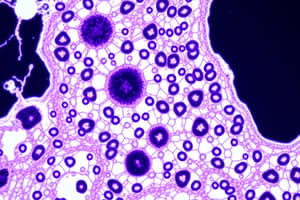Podcast
Questions and Answers
What is the primary function of mitosis in cell division?
What is the primary function of mitosis in cell division?
- Creating gametes that undergo fertilization
- Generating genetic variability in offspring
- Breaking down cell components for recycling
- Producing identical daughter cells for growth and tissue repair (correct)
Which component is NOT typically found in a eukaryotic cell?
Which component is NOT typically found in a eukaryotic cell?
- Ribosomes
- Plasmids (correct)
- Mitochondria
- Golgi apparatus
What is the main function of DNA in living organisms?
What is the main function of DNA in living organisms?
- Facilitating cellular respiration
- Storing genetic information (correct)
- Regulating cell division
- Producing proteins directly
Which process involves the formation of gametes for sexual reproduction?
Which process involves the formation of gametes for sexual reproduction?
In a cell, which organelle is responsible for energy production?
In a cell, which organelle is responsible for energy production?
Which type of cell division creates genetic variability in offspring?
Which type of cell division creates genetic variability in offspring?
What is the primary source of energy for living organisms?
What is the primary source of energy for living organisms?
Which macromolecules play a pivotal role in performing various functions within cells?
Which macromolecules play a pivotal role in performing various functions within cells?
What process involves digestion, absorption, and metabolism of food within organisms?
What process involves digestion, absorption, and metabolism of food within organisms?
Which structures enable organisms to navigate their environments for survival purposes?
Which structures enable organisms to navigate their environments for survival purposes?
What do ecological niches define within an ecosystem?
What do ecological niches define within an ecosystem?
Which level of biology examines interactions between various species within habitats?
Which level of biology examines interactions between various species within habitats?
Flashcards are hidden until you start studying
Study Notes
Biology: An Introduction to Life Processes
Biology, the science of life study, is a vast discipline encompassing various branches ranging from genetics, zoology, botany, microbiology, and more. It offers insights into how living beings evolve, reproduce, grow, interact with their environment, and maintain homeostasis. At its core, biology delves into the intricate details of life processes, from molecular structures within cells to ecosystem dynamics involving diverse organisms. Through rigorous experiments, observation, and theory development, scientists continue expanding our knowledge of life's complexities.
Cellular Level: Understanding Basic Building Blocks
The foundation of life lies at the cellular level. Cells are the tiny building blocks that consist of several components, namely cytoplasm, nucleus, mitochondria, ribosomes, endoplasmic reticulum, Golgi apparatus, lysosomes, and peroxisomes. Each component plays a significant role in maintaining the functionality of the cell.
Two primary forms of cell division occur in biology: mitosis and meiosis. Mitosis, known as somatic cell division, produces identical daughter cells for growth and tissue repair. On the other hand, meiosis creates gametes, which undergo fertilization to generate offspring.
DNA Structure and Replication
DNA, deoxyribonucleic acid, serves as the genetic blueprint of life. Its structure consists of two strands twisted together, creating a double helix. During DNA replication, the strands separate, allowing new complementary bases to join together, forming a fresh complete DNA molecule.
Protein Synthesis
Proteins, essential macromolecules made up of amino acids, play a pivotal role in performing various functions within cells. The process of protein synthesis comprises transcription, transfer RNA (tRNA) binding, translation, and post-translational modifications.
Organismal Level: Exploring Living Beings
At the organismal level, biology investigates the interactions between various factors and how they influence the survival and reproduction of individuals. Key aspects studied here include nutrition, movement, respiration, sensory perception, and reproduction.
Nutrition and Energy Metabolism
Living organisms require energy to carry out vital tasks. They obtain energy primarily through consumption of food, which undergoes digestion, absorption, and metabolism within organisms. Energy storage molecules like glycogen, starch, and lipids provide fuel when food sources are limited.
Movement and Locomotion
Organisms have evolved diverse methods for movement, such as cilia, flagella, muscles, and wings. These structures enable organisms to navigate their environments for survival purposes.
Population and Ecosystem Level: Understanding Community Interactions
At this level, biology examines how various species interact within their habitats, forming complex ecosystems. Factors studied here include population dynamics, symbiotic relationships, competition, predator-prey interactions, and nutrient cycling.
Ecological Niches
Species occupy unique ecological niches, which define their roles within an ecosystem based on resource availability and environmental conditions. Overlap between niches can lead to coexistence, while excessive overlap may result in competitive exclusion.
Understanding these levels provides a comprehensive overview of the biological world, emphasizing the importance of interconnectedness across all life processes. Exploring further into specialized topics allows researchers to uncover new discoveries and expand our comprehension of life processes.
Studying That Suits You
Use AI to generate personalized quizzes and flashcards to suit your learning preferences.




